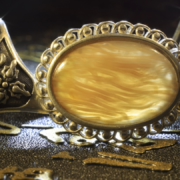How does the condition of jewelry affect its resale value?
The condition of jewelry plays a significant role in determining its resale value. Here are the main factors that influence this:

1. Overall Condition
- Pristine/Excellent Condition: Jewelry that is in excellent condition, meaning it has been well-maintained and shows minimal signs of wear and tear, tends to retain or even increase in value, especially for high-quality or designer pieces.
- Signs of Wear: Items with noticeable scratches, dents, or tarnishing will typically be worth less, as they require repairs or refinishing to restore their appearance.
- Stone Integrity: If gemstones are chipped, cracked, or missing, it can significantly lower the resale value of the jewelry, as repairs or replacements are costly.
2. Reputation of the Maker or Designer
- High-end, well-known designers or brands like Cartier, Tiffany & Co., or Van Cleef & Arpels can maintain their value or even appreciate over time, provided the piece is in good condition.
- Limited Editions: Rare or limited-edition pieces, particularly from iconic designers, can retain or increase in value even if they show signs of wear, as their rarity and craftsmanship are often seen as more valuable than condition alone.
3. Metal Quality and Condition
- Gold, Platinum, and Silver: The metal composition and condition matter. For example, gold jewelry that is scratched or has lost its luster can be refinished, but if it is deeply scratched or warped, its resale price can drop.
- Platinum: Being a durable and precious metal, platinum jewelry tends to maintain value better, but significant signs of wear, like thinning or tarnishing, will affect resale value.
- Silver: Silver pieces often tarnish over time. While tarnish can often be cleaned off, heavily tarnished or corroded silver pieces may be worth less.
4. Maintenance and Repairs
- Jewelry that has been properly maintained and cared for, such as cleaned regularly or professionally restored, will likely command a higher resale price.
- If repairs have been done by reputable jewelers, this can positively influence resale value, but poor-quality repairs or mismatched parts can decrease it.
5. Original Packaging and Documentation
- Certificates of Authenticity: For fine jewelry, especially high-value pieces or designer jewelry, having the original documentation (such as certificates for gemstones, appraisal reports, or receipts) can significantly increase the resale value.
- Original Packaging: While not always a major factor, having the original box or packaging can enhance the appeal of the jewelry and increase its resale value, especially for collector’s pieces.
6. Market Trends
- Jewelry trends can also affect resale value. For example, if a particular style or gemstone is in high demand, even a slightly worn piece might fetch a higher price than expected.
- Vintage and antique jewelry in excellent condition can sometimes fetch more than newer pieces, depending on its historical significance and rarity.
7. Gemstone Condition
- Color and Clarity: Stones that are clear, well-cut, and retain their color and brilliance typically fetch a higher resale price.
- Synthetics vs. Natural Stones: The presence of synthetic or treated gemstones may lower the value compared to natural stones, even if the jewelry is in perfect condition.
- Prong Settings and Secure Mounting: If the gemstones are securely set, with no loose or wobbly stones, this will keep the resale value higher.
8. Resale Channels
- Jewelry Store or Auction: Resale value can vary based on where you’re selling the jewelry. Jewelry stores typically offer less than auction houses or private buyers due to the need to make a profit.
- Online Resale: Online platforms (like eBay, Etsy, or specialized jewelry resellers) might provide a higher resale price, especially for vintage or designer pieces, but often at the cost of more effort and potentially higher fees.
In summary, the better the condition of the jewelry, the higher the resale value. If you’re thinking of reselling, maintaining your jewelry and taking care of it through regular cleaning and repair can help maximize its value. Additionally, ensuring that any documentation, such as certificates and appraisals, are kept intact can boost the price when reselling.






Leave a Reply
Want to join the discussion?Feel free to contribute!